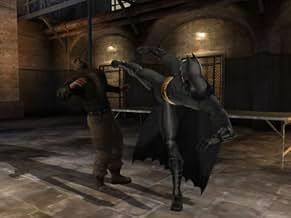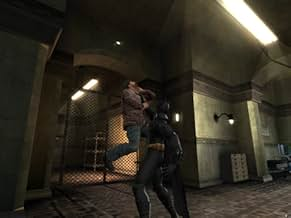The childhood of the Bat has morphed into adult cinema. Instead of the familiar cartoonish, studio-bound, theatrical, and computer-generated spectacle, “Batman Begins” (2005) offers real locations with selective, demonstrative infusions of graphics and stunts. The real roots of the comics, Batman’s place in life – that’s the idea behind this latest installment. It’s initially shocking, but as my American neighbor said, “That’s the whole point.”
It’s interesting to watch, no need to spoil it. It’s all there: an age of innocence, an orphan in a storm, your home is a prison, seven years in Tibet, a return that’s not à la Zvyagintsev, two fortresses, Figaro here, Figaro there, deadly weapons, enemy at the gates, and the day after tomorrow – a triumph of will, a victory of faith. It seems like Nolan has gotten audacious. Christopher Nolan meticulously assembled the backstory of Bruce Wayne, known as Batman, from well-worn children’s blocks. The thousand-year-old secret organization “League of Shadows” is a pure echo of the thousand-year-old backstory of the latest “Exorcist: The Beginning” (2004). Its Tibetan location is from “Bulletproof Monk” (2003). The journalistic and police frenzy around the Batman is exactly like “Spider-Man” (2002), just as the train crash on the overpass later is a carbon copy of “Spider-Man 2” (2004). Bruce’s equipment process at Lucius Fox’s is classic Q in Bond films, from the Batmobile to the antidote. “The Phantom of the Opera” (2004), “Finding Neverland” (2004), and “Gosford Park” (2001) flash by at balls and in memories. The very fact that the orphan Bruce Wayne, like Anakin Skywalker, grew up in despair but ended up in a circle of peculiar “Jedi,” emerges not as the terrifying monster Darth Vader, but as a good Batman – a clear antithesis to the latest “Star Wars: Episode III - Revenge of the Sith” (2005).
Every frame of “Batman Begins” is specifically shot “in the style of something else,” lock, stock, and barrel. Nevertheless, this eclecticism, like poverty, is no vice. It’s smart, meaning it’s carried out across the board, along all lines of life, giving it cohesion, which is what makes it “cinema.” Nolan didn’t steal, but worked diligently, sweating to not miss a single opportunity for imitation. Because by not missing it, he thereby proves that the Batman mythology is more complete, stronger, and richer than all the cited sources; it doesn’t miss anything itself. And “Batman” as a comic is the archetype of all possible comics. And it worked because the guy didn’t even spare himself, his beloved self. Nolan used his highly intellectual “Memento” (2000) and “Insomnia” (2002) to make the action of “Batman Begins” unfold in three formats simultaneously – the distant past, the recent past, and the present. In the editing, the times are mixed like cards (“joker”), and the interest lies in each forehead in the audience testing their knowledge of the mythology. Nolan also didn’t spare the history of the USA. In the fictional Gotham City (quasi-New York), there have been revolutions (the American Civil War), economic collapses (the Great Depression), and kind uncles (Roosevelt). Papa Wayne grew entirely out of Capra’s “folk comedies,” contemporary to the birth of the comic (“You Can’t Take It with You” (1938), “Mr. Deeds Goes to Town” (1936), “Mr. Smith Goes to Washington” (1939)), and his son didn’t go far (“Meet John Doe” (1941)). It’s cool how all this is explained – by the thousand-year-old “international terrorism” of the League of Shadows, which is immediately topical, patriotic, and quite ironic (“what can you take from a comic”).
Casting Choices and Their Implications
In the same vein, Nolan played around with the casting. It’s not just that Christian Bale is the first Batman actor who matches the specified height (188 cm). He’s the first actor who risks getting lost in the Hollywood bamboo (Michael Caine, Liam Neeson, Morgan Freeman, Gary Oldman, Rutger Hauer, Tom Wilkinson, Ken Watanabe, Rade Serbedzija). Bale is relatively little known (“Reign of Fire” (2002) barely, a little bit of “Cold Mountain” (2003), well, and “The Machinist” (2004)), and Nolan gives him a lot of big scenes to play, and he never gets lost. He’s awkward but persistent in his robe, tuxedo, and domino mask. Therefore, the entire “bamboo” also becomes eclecticism – just like in the classic, recently remade “Around the World in 80 Days” (2004), only stars played. But again, instead of theft, it’s a precise calculation on American intuition. Because in the comic, Michael Caine plays not only the ironic-sentimental butler Alfred, but also “how Michael Caine in the comic plays the butler.” The “negative” guru Neeson, who here avenged Hollywood for all his “positive” gurus (“Star Wars: Episode I - The Phantom Menace” (1999), “Kingdom of Heaven” (2005)), Hauer in roughly the same spirit, the “positive” Oldman, clearly playing a role, even with a mustache belonging to William Macy, and also avenging the “sharply negative” “The Fifth Element” (1997) – this is enough wealth of associations and relationships to make eclecticism a reality. Bale is even given “little-known” support: the modest Cillian Murphy from “Disco Pigs” (2001) (Dr. Crane) strengthened his role as a pervert with an angelic face.
The World of Batman: A Reflection of Our Own
Only Katie Holmes (Rachel) seems bland, because, unlike America, we don’t know her well, but, well, Nolan had a more difficult task than being distracted by us. If harnessing a horse and a timid doe into the same cart of plot, relationships, faces, and their biographies is only half the battle, then how to deal with the appearance of the world, with pure visibility, so that the drawn flights of Batmobiles under the roofs of Paris and over a raised bridge don’t seem more vulgar than an absolutely normal old mansion with a butler and a lawn? Nolan did two things with the appearance of the world. First, it’s extremely diverse, so that “quality” for him becomes not the implementation of this or that style, but precisely the maximum of styles, from Empire to techno. It’s cool to watch the frock coats of gentlemen in a new generation express train. Second, New York still saves the day. When you remember the CNN broadcast of September 11, anything can happen in this city of Gotham. In some ways, “Batman Begins” is aesthetically opposed to “Sin City” (2005), but it’s not without reason. This time, a general picture of the world is given not “from the point of view of justice,” but “from the point of view of the struggle for justice.” That is, for Nolan, it’s as if it goes without saying that justice exists, and in order for such a thing to be taken for granted today, without convulsive rushing, without eclecticism, it’s impossible to do without. And let the happy ending be subjective – it has the right to subjectivity if it stipulates it. Batman spreads his wings, the Joker leaves a card – everything is stipulated quite carefully.

Batman Begins: A New Type of Drama
The movie turned out great, and this is already a trend. Recently, Americans have been reaching heights precisely in “low” genres. The exiled whores and bandits who came to America three hundred years ago were simple people, without a tower, without a superstructure. Therefore, any kind of philosophy, strength of spirit spreads, not as in Europe – from top to bottom, from the spiritual aristocracy – to the masses, but vice versa, evolutionarily. What the simple reach, they will inadvertently fix, and not in essays and treatises, but in paperbacks or in comic book adaptations. But, if they have already reached it, the “simple” will not give up an inch, and this trend means the introduction of new territories into the rank of general law. “Batman Begins” is a new legitimate type of drama. This is not a comedy. Let it be difficult for “our people” to watch it, and many will send it packing. If we reach Europe, it is unknown when. But with Americans, it is now known to be easy to talk about something complex: recently, their very mainstream cinema has begun to turn out at a quite European level of philosophy. Still, they were greatly shaken on September 11.

So, now they clearly distinguish good intentions from the place where the road to them is paved. That is, instead of “good and evil,” there are simply nuances of good and a distinction of the line beyond which it dries up. In “Batman Begins,” there is no longer a fatal villain (in the previous Batman series, he was usually the brightest star (Nicholson, Carrey, DeVito)). Neither Ken Watanabe nor Neeson are by no means knowingly bad guys. At first, I even thought they were nothing bad guys. But America finally postulates as law what is generally impossible. Freedom does not end there, “where your neighbor’s nose begins,” but much closer. Where your own Batman nose smells the smell of someone else’s fear. And you have no right to hide your nose in the mitten of the League of Shadows, no matter how many thousands of years old it is.
Your right is only to ensure that there is no smell at all. Neither in Tibet, nor in New York, nor in the Civil War, nor in the Great Depression, nor in a computer, nor from a piece of paper, from a paperback book.
